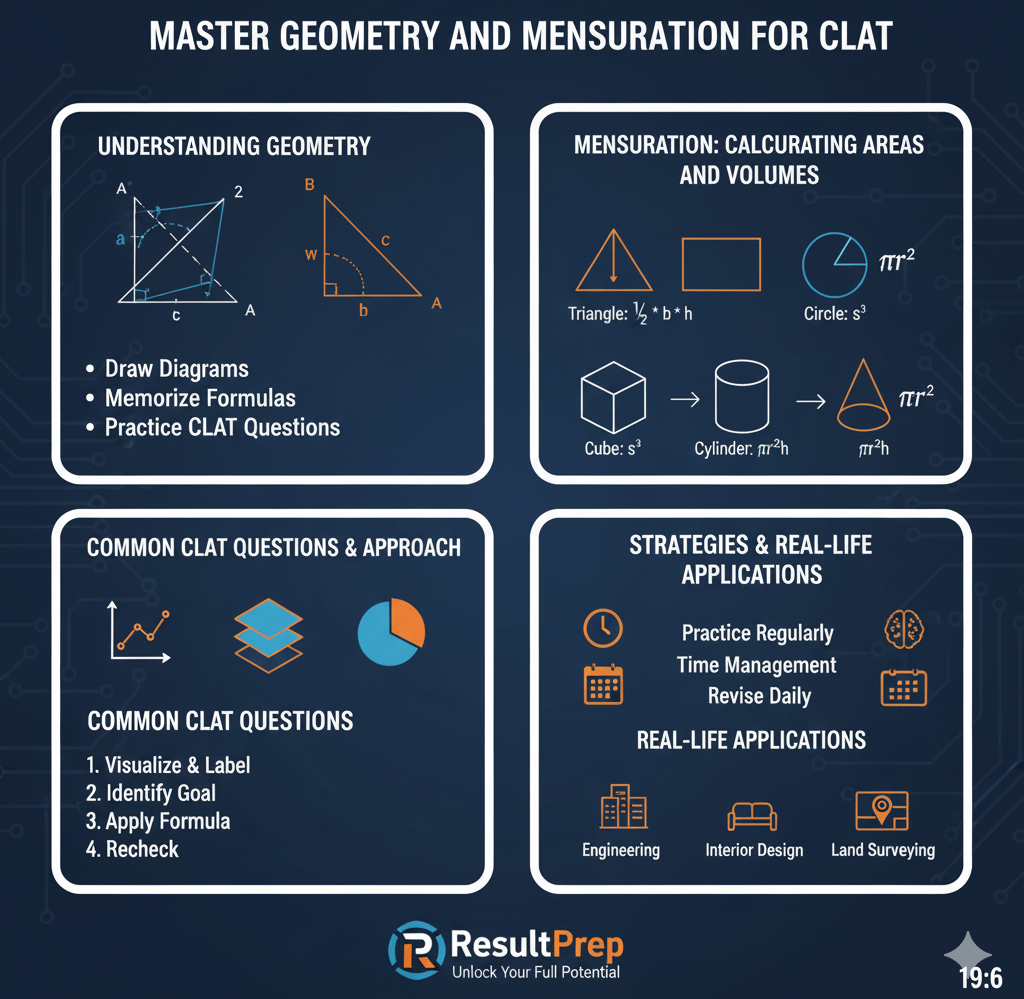Crack CLAT Quant with Geometry & Mensuration Mastery!
Boost your CLAT Quant scores with smart tricks, key formulas, and real-life tips on Geometry & Mensuration. 🚀 Learn to solve shapes, areas, and volumes with speed and accuracy — the ResultPrep way! 💡
LAW ENTRANCE
10/6/20253 min read


Quantitative Techniques: Master Geometry and Mensuration for CLAT
Introduction
Geometry and Mensuration form an important part of the Quantitative Techniques section in the CLAT exam. Although CLAT is primarily a law entrance exam, the quantitative section tests logical reasoning, problem-solving abilities, and accuracy, which are essential skills for a law aspirant. Questions in this section often involve shapes, areas, volumes, coordinate-based problems, and logical application of formulas. A strong grasp of geometry and mensuration not only helps in scoring well but also improves analytical thinking. This blog discusses the key concepts, practical strategies, examples, and tips for mastering these topics for the CLAT exam.
Understanding Geometry for CLAT
Geometry is the branch of mathematics that studies shapes, sizes, and properties of space. It is a key topic in the CLAT Quantitative Techniques section. Understanding concepts clearly is vital to solve questions efficiently.
Key Areas of Geometry:
Lines and Angles: Concepts like parallel lines, intersecting lines, angles formed by a transversal, and the sum of interior and exterior angles of polygons.
Triangles: Types (equilateral, isosceles, scalene), Pythagoras theorem, similarity, congruence, and basic properties of angles.
Circles: Chords, tangents, arcs, sectors, and related properties.
Quadrilaterals and Polygons: Properties and formulas for squares, rectangles, parallelograms, trapeziums, and regular polygons.
Tips for mastering geometry:
Always draw diagrams to visualize the problem.
Memorize key formulas for area, perimeter, and angles.
Solve previous years’ CLAT questions to understand patterns and difficulty levels.
Use shortcuts for frequently asked problems like angle sums, Pythagoras theorem, and basic coordinate geometry.
Mensuration: Calculating Areas and Volumes
Mensuration deals with measuring lengths, areas, and volumes of 2D and 3D objects. In CLAT, questions are usually designed to test practical application and logical reasoning rather than lengthy calculations.
Common 2D Figures:
Triangle: Area = 1/2 base height
Rectangle: Area = length * breadth
Circle: Area = pi radius^2, Circumference = 2 pi * radius
Trapezium: Area = 1/2 (sum of parallel sides) height
Common 3D Figures:
Cube: Volume = side^3, Surface Area = 6 * side^2
Cuboid: Volume = length breadth height, Surface Area = 2*(lengthbreadth + breadthheight + height*length)
Cylinder: Volume = pi radius^2 height, Surface Area = 2 pi radius * (height + radius)
Cone: Volume = 1/3 pi radius^2 height, Surface Area = pi radius * (radius + slant height)
Sphere: Volume = 4/3 pi radius^3, Surface Area = 4 pi radius^2
Tips for Mensuration:
Always check units before performing calculations.
Break complex figures into simpler shapes to make calculations easier.
Practice solving time-bound quizzes to improve speed.
Common CLAT Geometry and Mensuration Questions
CLAT tests conceptual clarity rather than complicated calculations. Some frequently asked questions include:
Calculating the area of triangles using Heron’s formula when all sides are given.
Determining surface area of composite solids like a hemisphere on a cylinder.
Finding the distance between points in coordinate geometry.
Solving ratio-based problems involving areas and volumes.
Approach for solving these questions:
Visualize the figure and label all dimensions.
Identify what is given and what needs to be calculated.
Apply the correct formula efficiently.
Recheck calculations to avoid errors, especially with pi and square roots.
Strategies to Master Geometry and Mensuration
Practice Regularly: Solve diverse problems to build confidence.
Memorize Formulas: Keep a separate sheet for all geometry and mensuration formulas.
Use Diagrams: Drawing accurate diagrams helps in understanding and solving problems faster.
Time Management: CLAT is a timed exam; practice solving questions within the given time.
Revise Daily: Frequent revision ensures quick recall during exams.
Real-Life Applications
Geometry and Mensuration are not just academic topics; they are useful in real life:
Engineering and Architecture: Calculating dimensions, material requirements, and designing structures.
Interior Design: Optimizing space while arranging furniture and decor.
Land Surveying: Measuring plots of land or irregular areas.
Navigation and Mapping: Triangulation, GPS mapping, and spatial problem-solving.
Conclusion
Mastering Geometry and Mensuration is essential for the Quantitative Techniques section in CLAT. Students must focus on conceptual understanding, formula memorization, and practice under timed conditions. Combining diagrammatic visualization, previous year questions, and shortcuts ensures accuracy, speed, and confidence.
At ResultPrep Coaching, we provide structured study materials, step-by-step problem-solving methods, and practice exercises to help CLAT aspirants master quantitative techniques efficiently. With consistent practice and conceptual clarity, students can tackle any geometry or mensuration problem with confidence and achieve top marks.
📞 Call: 8970007497
🌐 Visit: www.resultprep.com
Prepare for the best results!
Achieve your goals with expert coaching and support from ResultPrep.
Contact us:
© 2025. All rights reserved.
Address:
GSS Complex, 2nd Floor,
16th Cross Rd, HMT Layout, Vidyaranyapura, Bengaluru, Karnataka- 560097
